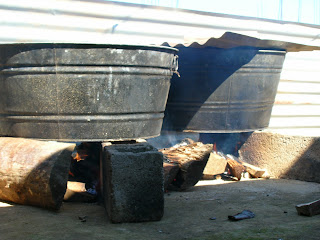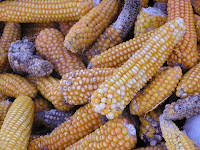Christmas in Guatemala seems to emphasize the 24th over the 25th. Actually, in my site we emphasized the time immediately before and after midnight between the 24th and 25th, leaving the rest of the holiday mainly quiet.
The 24th was a relaxed day at home. I spent the morning as a busy elf secretly putting the finishing touches on some decorative garlands that I made for the extended host family. I didn't have much money (or much of an idea what to spend it on), so I figured a little time and craftiness would go over just fine with the grandparents, aunts, and uncle.
 |
| My gift garlands, hanging over my bed/workshop. I told them the stars symbolized the star the Wise Men followed to Bethlehem, and that paper cranes are a symbol of peace (and my wishes for the New Year). |
In the afternoon we did a little decorating, such as placing the nacimiento (nativity scene) under the Christmas tree and spreading pine needles all over the front steps and patio (pine needles all over the ground is a must at any Guatemalan celebreation; birthday, wedding, graduation, you name it). I helped Ela make 50 tamales, which was a breeze after the 400 from two weeks ago.
 |
| Elkin (left) and Hendrick (right) posing around the tree and nativity scene. Mary got broken right after lunch... Benancio came in and joked that, "Elkin ya tiene un pecado," (Elkin's got a sin already) because Mary was in three pieces. We carefully balanced them together (no glue) and just tried not to touch the scene. |
As the evening wore on and the sun went down, the power went off. The previously festive blaring and clashing music (both pop hits from the radio and whining tin sounding holiday tunes emanating from blinking Christmas lights) disappeared, and the town went quiet. Ela started wrapping the kids presents by candle light out on the patio, while the kids watched and carried each gift off to set under the tree as she finished the wrapping. Since they had been along on the shopping expedition, there was no need for secrecy. I think they had already opened and started playing with more new toys than they ended up unwrapping later on... In the end the gifts from Tia Isabel and me were the only surprises.
The power eventually came back on around 9:30 p.m., which was good because we were all getting drowsy by candlelight. We had to make it to Midnight, that's when the celebration actually gets going! To await the hour, we dug into the tamales (two kinds, yum!), hot chocolate, magdalena cake, and ponche (hot drink sort of like cider; they throw a mix of dried fruits that come pre- sugared and spiced with cinnimon into boiling water and voila!). We also lit off a few small fireworks and sparklers to pass the time. Well, Benancio and Hendrick lit them, lighting the fuse with the firework still in hand and throwing it to the ground at the last minute. I stood safely to the side and enjoyed the show.
 |
| Ela's makeshift stove in the patio, heating ponche, tamales, and hot chocolate. |
At a few minutes before Midnight, the valley either could just not wait any longer, or had their clocks set just a bit faster than mine. The entire valley (ringed by several aldeas and a pueblo) erupted. I'm not sure I've ever experienced fireworks in quite that way -- one PCV friend texted me at midnight saying, "welcome to Apocolypo Christmas." It was like all the fireworks a medium sized city in the U.S. lights off over the whole week of 4th of July packed into half an hour starting at midnight! I took a video, and though my camera doesn't capture most of the visuals, just listen to the constant booms and pops and you'll get an idea of what I was experiencing.
Toward the end you can hear Hendrick shouting, "Y ahora es tiempo de abrir regalos!" ("and now time to open presents!"). So, even though he knew exactly what he was getting, his enthusiasm for opening the presents seemed undiminished.
 |
| Tio Oscar rolling out 25 meters of firecrackers. |
One of the former volunteers in my site observed to the family (and they repeated to me): En Guatemala, no hay dinero para comer, pero si hay para quemar! (In Guatemala, there isn't money to eat, but there is money to burn!). Once we had taken in as much explosions as we could handle (about half an hour later... the bursts showed no signs of stopping), we all trooped downstairs. We all hugged and said Feliz Navidad, opened presents, and had a second round of tamales. I snuggled into bed around 1:30 a.m.
 |
| My Chirstmas Corner of the room -- no tree, unfortunately. |
On Christmas day itself I had a Skype date with my family and participated in the round robin of opening presents, since my overly generous family had managed to send me plenty of packages (some of which are still on their way). They munched on our traditional almond danish puff, I munched on more tamales. The internet went out midway through, but it was enough to be able to kibitz with them some and share laughter. I read Charles Dickens' A Christmas Carol, which I'd found at the Peace Corps Office, and streamed holiday music from NPR's website. We got back in touch later in the day to finish catching up and to fill one another in on the presents opened after we lost the connection.
All in all, I enjoyed Christmas in Guatemala! It's easier to escape the commercialization of the holiday when your town is more or less outside of the formal economy. It was strangely fairly secular here, which I wouldn't have expected. I missed some of my own traditions, and certainly always love having a White Montana Christmas, but it was a blast to see the excitement of my Site family when the fireworks started, and I was reduced to giggling, hopping and pointing with glee. I hope the holiday was joyful for all of you -- whether full of old traditions or the beginning of some new ones!



















































